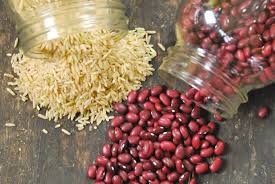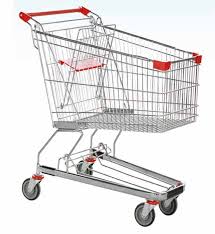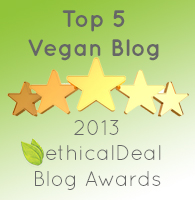 As a vegan for almost 5 years, one of the arguments I hear most often against plant-based nutrition is that “the cost of fresh fruits and vegetables is just too high.” I believe that this is one of the many myths surrounding veganism which has absolutely no basis in fact.
As a vegan for almost 5 years, one of the arguments I hear most often against plant-based nutrition is that “the cost of fresh fruits and vegetables is just too high.” I believe that this is one of the many myths surrounding veganism which has absolutely no basis in fact.
During a “question and answer” session following the premiere screening of the Forks Over Knives documentary, I clearly recall one of the audience members telling the panel that a vegan diet is just too expensive for many peoples’ budgets. I’ll never forget Rip Esselstyn’s priceless response…
“How much do rice and beans cost?”
A recent article in The Wall Street Journal significantly weakens the omnivores’ assertion that fresh fruits and vegetables are too costly to be the mainstay of their diets. In fact, the article states that vegans should now be “rejoicing” because meat prices are rising more than fresh fruits and vegetables, and that it’s a good time to be vegan. Apparently, meat prices are up 9.4% in June from a year earlier, and pork, fish and eggs are more expensive, too. According to Annemarie Kuhns, an economist at the U.S. Department of Agriculture, we are still seeing higher inflation among the foods located in the peripheral of the grocery store – meats, produce, dairy, etc. Although vegetarian-friendly foods rose as well, it was significantly less than the prices for omnivores.
 So far this year, a drought in Oklahoma and Texas has driven up cattle prices. A virus has killed millions of piglets and pushed up pork costs. Most of the shrimp eaten in the U.S. comes from Southeast Asia, where a bacterial infection has devastated inventory.
So far this year, a drought in Oklahoma and Texas has driven up cattle prices. A virus has killed millions of piglets and pushed up pork costs. Most of the shrimp eaten in the U.S. comes from Southeast Asia, where a bacterial infection has devastated inventory.
I believe that The Wall Street Journal article makes a great case for eating a plant-based diet. The rising cost of meat makes it a great time to choose eating vegetables over animals. Additionally, vegan staples such as beans, grains and pasta can be purchased in bulk making plant-based meals extremely nutritious and very inexpensive.
To bolster the case that eating vegan does not have to be expensive, I decided to re-post Ellen’s helpful article 20 Ways To Eat Plant-Based For Less. Ellen does a great job of busting the myth that plant-based nutrition costs more!
20 WAYS TO EAT PLANT-BASED FOR LESS
By Ellen Francis
Abandon the Myth! Plant-Based Nutrition Need Not Cost More!
One of the common misconceptions about adopting a plant-based diet is that it will cost more. People seem to assume that eating vegan necessitates buying exotic and expensive ingredients in specialty stores. Or that you need to find strange vegetables that you’ve never heard of and that are hard to find. But that couldn’t be further from the reality.
For me, it started with a leisurely, investigative stroll down the aisles at Whole Foods. It was life-changing. I’m fortunate to have two Whole Foods Supermarkets within 10 miles from me in opposite directions and a Trader Joe’s right in my town. I do know how lucky I am!
Flashback to about 3 years ago, pre-vegan: there I am…mindlessly tossing packages of chicken, meat, seafood and fish of all shapes and configurations into my cart each week, while hastily rushing through my local supermarket grabbing the only proteins I really knew. Every meal I made was meat-centric—I just had to have a substantial portion of animal protein in the center of the plate. The multitudes of dairy products, as well, stacked up in the cart. Of course, being what I thought was healthy-minded even then, I bought fresh fruits and vegetables, basic grains and white pastas, to serve as side dishes—sometimes organic and sometimes not, but the overwhelming bulk of the expense was always the many meat items.
The beginning of enlightenment was that first time in Whole Foods after making my decision to eliminate animal products from my diet. Not having to spend time focusing on all the various meat, chicken & fish items, I had more time to really explore and learn about interesting vegetables, amazing fruits, grains I always ignored and products I usually walked right by—and this transition, surprisingly, translated into a lower total at the cashier.
Before we get into a list of suggestions about how to be plant-based and spend less, the first thing to do is to change your mindset about how difficult or how expensive moving into a more plant-based diet has to be. It truly does not need to be either! The way I see it: I’m going food shopping either way, so instead of buying this, I’m buying that! Simple? See it as a journey into the exciting world of delicious discovery and healthful eating that will change your life, change the lives of animals and help the environment.
20 Ways to Go Vegan For Less $
1) Try to buy fresh fruits and vegetables in season (when they’re plentiful and less expensive)
2) Avoid pre-packaged fresh fruits and vegetables (they are often more expensive)
3) Buy locally grown produce (when they travel a long way, the price can reflect that)
4) Frequent Farmer’s Markets—often the prices are better!
5) Use “green” bags to keep produce fresher longer in the fridge
6) Buy frozen fruits and vegetables on sale—they are usually frozen right after being picked, locking in the nutrients
7) Buy basic whole grains in bulk: quinoa, barley, buckwheat & brown rice, etc.
8) Stock up on bags of inexpensive but high in protein foods: there are so many varieties of dried beans, legumes, lentils–and they have a long shelf life.
9) Always have organic tofu in the refrigerator—very versatile and high in protein!
10) Start gradually with plant-based meals 2-3 days per week or 1-2 meals per day
11) Avoid expensive packaged vegan meals unless they are on sale.
12) Buy whole wheat pastas when the price is right and stockpile
13) Plant-based “meat” and “cheese” substitutes can be a bit pricey (and sometimes not that healthy) so don’t go overboard
14) Check the supermarket flyer for what fruits, veggies, grains are on sale and build some meals around those items.
15) Head to Costco with a friend and share the huge sizes of fruits and vegetables (that’s always a good idea if you can do it!)
16) Move through the aisles of the supermarket slowly to take note of interesting items that you never noticed before—there are tons of them!
17) Google some simple vegan recipes that use only a only handful of ingredients, print them up, and collect them. Vegan American Princess has many! Bring some to the supermarket for ideas.
18) Buy something new and interesting, if the price is right, each week—you can find a recipe for it later!
19) At home, plan some meals ahead of time before you head to the market.
20) See food choices in a whole new, healthy way!
Love, Ellen xoxo
Click here to read Go For It: Veggies In Bulk At Costco & 8 Recipes To Use Them All Up!









